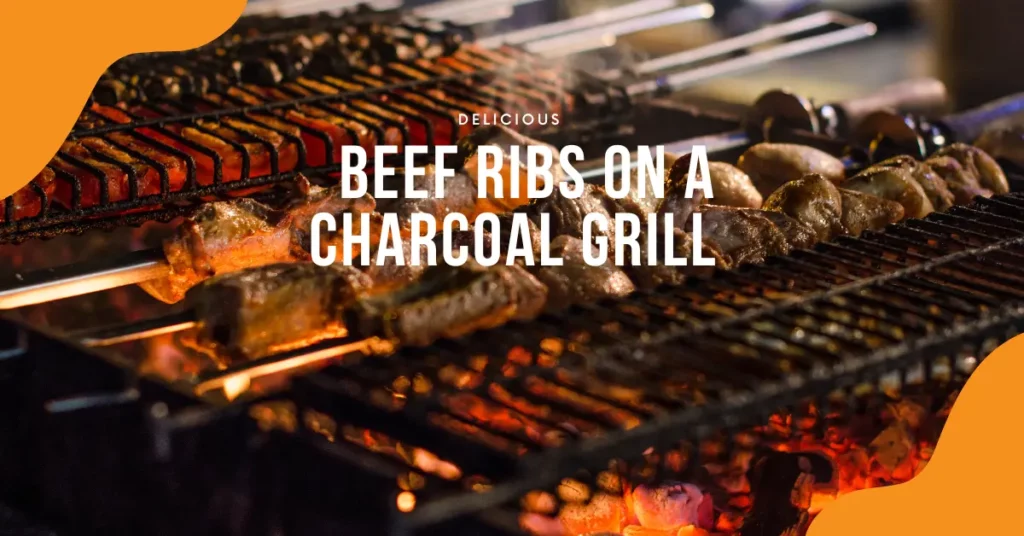This post may contain affiliate links. If you use these links to buy something we may earn a small commission. Thanks.
Beef ribs, when cooked to perfection, are a smoky, tender delight that can steal the show at any barbecue. Grilling them on a charcoal grill brings out their rich, beefy flavor, enhanced by the aromatic smoke from the coals. However, achieving this perfection requires patience, proper technique, and attention to detail. In this guide, we’ll walk you through every step of the process, from preparation to serving, to ensure your beef ribs turn out mouthwateringly good.
Preparing the Beef Rib
The journey to tender, flavorful beef ribs begins with proper preparation. Whether you’re working with short ribs or back ribs, a little attention before grilling goes a long way.
1. Trimming the Ribs: Start by removing any excess fat and the silver skin from the meat. The silver skin is a tough, membrane-like layer that won’t break down during cooking. Use a sharp knife to lift one corner of the membrane, grip it with a paper towel, and pull it off in one piece if possible.
2. Seasoning the Ribs: Seasoning is key to enhancing the flavor of your beef ribs. Create a dry rub using a combination of spices such as paprika, garlic powder, onion powder, black pepper, salt, and brown sugar. This blend strikes a balance between savory and slightly sweet notes. For an extra layer of flavor, you can apply a thin coating of mustard or oil to the ribs before applying the rub. This helps the seasoning stick better.
3. Marinating (Optional): For those who love deeply infused flavors, marinating the ribs overnight is a great option. Use a marinade based on your taste preferences—it could be a mixture of soy sauce, Worcestershire sauce, garlic, and herbs. Place the ribs in a resealable bag or container, ensuring they’re evenly coated, and refrigerate them for at least two hours or overnight.
Setting Up the Charcoal Grill
A properly set-up charcoal grill ensures even cooking and imparts a smoky flavor that’s hard to replicate with other methods.

1. Create an Indirect Heat Zone: Arrange the charcoal on one side of the grill to create a 2-zone setup. This allows you to cook the ribs slowly over indirect heat, preventing them from burning while they tenderize.
2. Add a Drip Pan: Place a drip pan filled with water or apple juice beneath the ribs on the cooler side of the grill. This adds moisture to the environment, keeping the ribs juicy and flavorful.
3. Preheat the Grill: Bring the grill to a temperature of 250–275°F (121–135°C). This low-and-slow temperature range is ideal for breaking down the connective tissues in the meat without drying it out.
4. Add Wood for Smoke: For that signature barbecue flavor, toss wood chunks or chips, such as hickory, oak, or mesquite, onto the hot coals. Soak the wood in water for 30 minutes before adding it to the grill to produce consistent smoke.
Cooking the Beef Ribs
With the grill ready and the ribs seasoned, it’s time to get cooking. This step requires patience, as the best beef ribs are cooked low and slow.
1. Placing the Ribs on the Grill: Position the ribs bone-side down on the cooler side of the grill. This indirect heat ensures the meat cooks evenly without charring.
2. Cooking Time: Beef ribs typically take 4–6 hours to cook, depending on their size and thickness. Keep the grill’s temperature steady within the 250–275°F range by adding more charcoal as needed.
3. Spritzing the Ribs (Optional): Every 45–60 minutes, lightly spray the ribs with a mixture of apple juice, vinegar, or a combination of both. This helps keep the meat moist and enhances the flavor.
The Texas Crutch (Optional)
For those who want ultra-tender ribs with reduced cooking time, the Texas Crutch method is a popular option.
1. Wrapping the Ribs: Around the 3-hour mark, remove the ribs from the grill and wrap them tightly in aluminum foil or butcher paper. Add a splash of liquid inside the wrap, such as apple cider vinegar, beef broth, or a mixture of barbecue sauce and water. This step locks in moisture and accelerates the cooking process.
2. Return to the Grill: Place the wrapped ribs back on the grill and continue cooking for another 1–2 hours.
Checking Doneness
Knowing when your beef ribs are done is crucial. Overcooking can dry them out, while undercooking leaves them tough.
1. Internal Temperature: Use a meat thermometer to check the ribs’ internal temperature. For tender, fall-off-the-bone ribs, aim for 200–205°F (93–96°C).
2. Probe Test: Insert a toothpick or skewer into the meat. If it slides in and out with no resistance, your ribs are perfectly done.
Resting the Ribs
Once the ribs reach the desired doneness, it’s important to let them rest.
1. Resting Time: Remove the ribs from the grill and leave them wrapped for 15–20 minutes. This resting period allows the juices to redistribute throughout the meat, ensuring every bite is juicy and flavorful.
Serving the Ribs
With your beef ribs cooked to perfection, it’s time to serve them up.
1. Slicing the Ribs: Use a sharp knife to slice between the bones, ensuring each piece has a generous amount of meat.
2. Adding Sauce: Serve the ribs as-is for a smoky, seasoned flavor, or brush them with your favorite barbecue sauce for a sweet and tangy finish.
3. Pairing Suggestions: Beef ribs pair well with classic barbecue sides such as coleslaw, baked beans, cornbread, or grilled vegetables. A refreshing beverage, like iced tea or craft beer, completes the meal.
Conclusion
Cooking beef ribs on a charcoal grill is a labor of love that rewards you with deeply flavorful, tender meat. From proper preparation and grill setup to patient cooking and thoughtful serving, every step contributes to the final result. So fire up your charcoal grill, take your time, and enjoy the process—and the compliments—that come with mastering beef ribs. Whether it’s a family gathering or a weekend cookout, your perfectly grilled ribs are sure to be the highlight of the meal.
